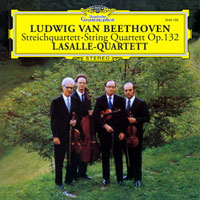Beethoven • String Quartet, Op.132 LaSalle Quartett: Walter Levin, Henry Meyer (violin), Peter Kamnitzer (viola), Lee Fiser (cello)
These last quartets were not only technically and musically ahead of their time then, they remain, as Stravinsky said of Opus 133, "eternally modern." Many consider them the pinnacle of the genre, yet others find them mysterious. Beethoven himself remarked: "I think of these last quartets as not necessarily being for [public] performance." More than a few of his audiences struggled to accept them. About the Quartet in A minor, album-notes author Emil Platen is humorously direct: "Op.132 frequently resists direct unprepared comprehension." Op.132 is different from any quartet Beethoven previously composed. The first movement offers enough counterpoint, dissonance and the use of swift dynamic changes in place of melodic resolution that it hints at a modernism yet to come. The Scherzo offers a quasi-waltz followed by a musette that looks back to Bach, while a droning string technique will later inspire Bartók. Lines are delightful yet confounding; they spin round themselves yet go nowhere. There is little to connect the movements together beyond a four-note introductory structure and perhaps a vague sense of foreboding for what is about to happen. Still, there is obvious genius here, as Beethoven offers uniquely sweet phrasings and semi-solos for both viola and cello. After writing the first two movements, Beethoven fell grievously ill, spitting up blood from intestinal inflammation. Rapid deterioration and pain stopped his work. Although recovery took only a month, Beethoven knew this illness was more dangerous than the usual chronic ailments he suffered. Here was a close brush with death, and his appreciation for another chance at life compelled him to express his gratitude in the best way he knew how. The third movement becomes the piece’s emotional center. It begins with a hymn-like choral fugue with chording from the four string instruments that led me to believe he could hear an organ playing. The movement turns processional then lively. Here the score is inscribed "a feeling of new strength." The effect of this musical prayer is striking, unexpected and beautiful. The short fourth movement marches sprightly without pause into the fifth, where the music, featuring the cello, regains a darker cast. Musical lines surge headlong, yet again fail to resolve. It’s as if the music got over its joy at recovery to return to a darker place close to where it began, close to the hardship Beethoven experienced in his last years. But the maestro always liked a rousing end, and the coda sheds the preceding dissonant ballast to effervesce joyfully in finale. Upon completion, Beethoven gave the entire work the heading "A Convalescent’s Holy Song of Thanksgiving to the Deity, in the Lydian Mode." The LaSalle Quartett gained prominence in the post-war years; with varied players, the group was active between 1946 and 1987. Best remembered as masters of and advocates for the Second Viennese School, their recordings of the string music of Schoenberg, Webern, Zemlinsky and others in that genre continue noteworthy to this day. Perhaps drawn to the modernist, forward-looking character of Beethoven’s last quartets, the LaSalles recorded them all for Deutsche Grammophon between 1972 and 1977. The Quartett brings technical virtuosity and their own distinctive intonation to Op.132, delivering a somewhat darker tone that proceeds at a slower tempo than other performances of this work. Their voices offer a slightly thicker sweetness that can sound more blended than individuated. Part of that may come from the proximity of the players to one another on this recording. Their technique works well in Op.132’s chordal third movement. From stern classical proportions to emotive romanticism, quartet sound shifts stylistically with the times. The LaSalle sound is from an earlier one, preceding my imprinting with the Amadeus Quartet. Still, I appreciated the group’s skill, obvious commitment and affection for the music. Sonically, the performance has only the barest sense of
air. I had to listen closely to catch harmonics rising off strings, and there was no
evidence of acoustic context. If all that doesn’t bother you, the album could warrant
another half star for sound. Speakers Corner notes that the remastering from the original
analog tape required no equalization. The Pallas-pressed record had no flaws and quiet
surfaces. |

 eethoven’s
Op.132 is one of six string quartets he wrote between 1823 and shortly before his death in
1827; they were his final compositions. Even in the face of physical, financial and
emotional suffering, he pushed these last works beyond contemporary boundaries, which led
him to explore new forms; and ever the scholar, he informed these quartets with his
renewed interest in Bach’s fugal mastery.
eethoven’s
Op.132 is one of six string quartets he wrote between 1823 and shortly before his death in
1827; they were his final compositions. Even in the face of physical, financial and
emotional suffering, he pushed these last works beyond contemporary boundaries, which led
him to explore new forms; and ever the scholar, he informed these quartets with his
renewed interest in Bach’s fugal mastery.